| Listing 1 - 7 of 7 |
Sort by
|
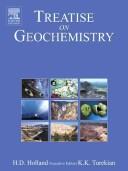
ISBN: 0080443370 0080437516 0080443400 0080443397 0080443389 0080443362 0080548075 Year: 2004 Publisher: Amsterdam : Elsevier/Pergamon,
Abstract | Keywords | Export | Availability | Bookmark
 Loading...
Loading...Choose an application
- Reference Manager
- EndNote
- RefWorks (Direct export to RefWorks)
Geochemistry --- 550.4 --- Chemical composition of the earth --- Chemical geology --- Geological chemistry --- Geology, Chemical --- Chemistry --- Earth sciences --- 550.4 Geochemistry --- Geochemistry. --- Géochimie --- Monograph
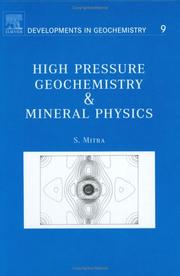
ISBN: 1280630884 9786610630882 008045822X 0444512667 9780444512666 9780080458229 9781280630880 6610630887 Year: 2004 Publisher: Amsterdam ; Boston : Elsevier,
Abstract | Keywords | Export | Availability | Bookmark
 Loading...
Loading...Choose an application
- Reference Manager
- EndNote
- RefWorks (Direct export to RefWorks)
Significant achievements have been made at the cross-roads of physics and planetary science. In the second half of the twentieth century, the discipline of planetary sciences has witnessed three major episodes which have revolutionized its approach and content: (i) the plate-tectonic theory, (ii) human landing and discoveries in planetary astronomy and (iii) the extraordinary technical advancement in high P-T studies, which have been abetted by a vast improvement in computational methods. Using these new computational methods, such as first principles including ab initio models, calculations h
Geochemistry. --- High pressure chemistry. --- Mineralogy. --- Planetology. --- Planetary sciences --- Planetology --- Physical geology --- Crystallography --- Minerals --- Chemistry, Physical and theoretical --- High pressure (Science) --- Chemical composition of the earth --- Chemical geology --- Geological chemistry --- Geology, Chemical --- Chemistry --- Earth sciences --- Planetary science.
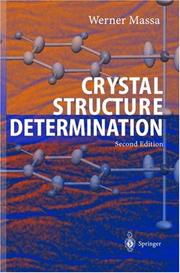
ISBN: 3540206442 3642058418 3662064316 Year: 2004 Publisher: Berlin Springer
Abstract | Keywords | Export | Availability | Bookmark
 Loading...
Loading...Choose an application
- Reference Manager
- EndNote
- RefWorks (Direct export to RefWorks)
To solve a crystal structure means to determine the precise spatial arrangements of all of the atoms in a chemical compound in the crystalline state. This knowledge gives a chemist access to a large range of information, including connectivity, conformation, and accurate bond lengths and angles. In addition, it implies the stoichiometry, the density, the symmetry and the three dimensional packing of the atoms in the solid. Since interatomic distances are in the region of100-300 pm or 1-3 A, 1 microscopy using visible light (wavelength Ä ca. 300-700 nm) is not applicable (Fig. l. l). In 1912, Max von Laue showed that crystals are based on a three dimensionallattice which scatters radiation with a wavelength in the vicinity of interatomic distances, i. e. X -rays with Ä = 50-300 pm. The process bywhich this radiation, without changing its wave length, is converted through interference by the lattice to a vast number of observable "reflections" with characteristic directions in space is called X-ray diffraction. The method by which the directions and the intensities of these reflections are measured, and the ordering of the atoms in the crystal deduced from them, is called X-ray struc ture analysis. The following chapter deals with the lattice properties of crystals, the starting point for the explanation of these interference phenomena. Interatomic distances Crystals . . . . . . . . . .
Radiochemical analysis --- fysicochemie --- X-ray crystallography. --- Radiocristallographie --- Inorganic chemistry. --- Organic chemistry. --- Geochemistry. --- Mineralogy. --- Physics. --- Inorganic Chemistry. --- Organic Chemistry. --- Physics, general. --- Natural philosophy --- Philosophy, Natural --- Physical sciences --- Dynamics --- Physical geology --- Crystallography --- Minerals --- Chemical composition of the earth --- Chemical geology --- Geological chemistry --- Geology, Chemical --- Chemistry --- Earth sciences --- Organic chemistry --- Inorganic chemistry --- Inorganic compounds
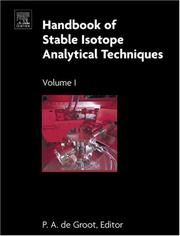
ISBN: 9780444511140 9780444511157 0444511148 0444511156 9786611055042 1281055042 0080533272 9786612541032 128254103X 0080930115 9780080533278 Year: 2004 Publisher: Amsterdam Boston Elsevier
Abstract | Keywords | Export | Availability | Bookmark
 Loading...
Loading...Choose an application
- Reference Manager
- EndNote
- RefWorks (Direct export to RefWorks)
(Parent with price) Volume I contains subjective reviews, specialized and novel technique descriptions by guest authors. Part 1 includes contributions on purely analytical techniques and Part 2 includes matters such as development of mass spectrometers, stability of ion sources, standards and calibration, correction procedures and experimental methods to obtain isotopic fractionation factors.Volume II will be available in 2005.
Stable isotopes --- Isotope geology --- Analytical geochemistry --- Isotopes stables --- Géologie isotopique --- Géochimie analytique --- Analysis --- Handbooks, manuals, etc. --- Analyse --- Guides, manuels, etc. --- Geochemistry --- Chemical composition of the earth --- Chemical geology --- Geological chemistry --- Geology, Chemical --- Chemistry --- Earth sciences --- Isotope geochemistry --- Nuclear geochemistry --- Nuclear geology --- Nuclear geophysics --- Stable isotope geology --- Physical geology --- Isotopes --- Analytic geochemistry --- Geochemical analysis --- Geochemistry, Analytic --- Analytical chemistry
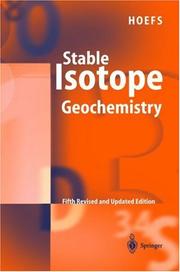
ISBN: 3540402276 3662054086 366205406X 9783540402275 Year: 2004 Publisher: Berlin: Springer,
Abstract | Keywords | Export | Availability | Bookmark
 Loading...
Loading...Choose an application
- Reference Manager
- EndNote
- RefWorks (Direct export to RefWorks)
Stable Isotope Geochemistry is an introduction to the use of stable isotopes in the geosciences. It is subdivided into three parts: - theoretical and experimental principles; - fractionation mechanisms of light and heavy elements; - the natural variations of geologically important reservoirs. The 5th edition has been revised and extended and now includes a new chapter on palaeoclimatology. Special emphasis has been given to the growing field of "heavy" elements. Many new references have been added, which will enable quick access to recent literature. For students and scientists alike the book will be a primary source of information with regard to how and where stable isotopes can be used to solve geological problems.
Geochemistry. --- Isotope geology. --- Géochimie --- Géologie isotopique --- Géochimie --- Géologie isotopique --- Geochemistry --- Isotope geology --- Isotope geochemistry --- Nuclear geochemistry --- Nuclear geology --- Nuclear geophysics --- Stable isotope geology --- Chemical composition of the earth --- Chemical geology --- Geological chemistry --- Geology, Chemical --- Physical geology --- Chemistry --- Earth sciences --- Geology. --- Mineral resources. --- Mineralogy. --- Oceanography. --- Sedimentology. --- Mineral Resources. --- Petrology --- Oceanography, Physical --- Oceanology --- Physical oceanography --- Thalassography --- Marine sciences --- Ocean --- Crystallography --- Minerals --- Deposits, Mineral --- Mineral deposits --- Mineral resources --- Mines and mining --- Mining --- Natural resources --- Geology, Economic --- Geognosy --- Geoscience --- Natural history
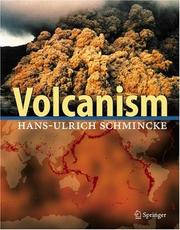
ISBN: 3540436502 364262376X 3642189520 9783540436508 Year: 2004 Publisher: Berlin : Springer,
Abstract | Keywords | Export | Availability | Bookmark
 Loading...
Loading...Choose an application
- Reference Manager
- EndNote
- RefWorks (Direct export to RefWorks)
he reason why I wrote a book on volcanism quoted is in no way re A volcano is not made on purpose to frighten in German (secondeditionpublished in2000) presentative. In view of superstitious people intofits ofpietyand devo Trather than in English. the lingua franca of the large amountoflit tion; nor to overwhelm devoted cities with science, was simple. The intended users of this eratureconsulted when destruction;avolcanoshould be considered asa writing this volume, I book were not only scientists and beginning stu spiracletothe subterraneanfurnace, in orderto dents in the Earth sciences,but also school teach have not been able to prevent the unnecessary elevation of land, and ers and lay people interested in volcanoes. The trace back some infor let. al effKts ofearthquakes. updated English translation likewise attempts to mation to ilS primary Jam~ Hutton, Th~ry o/the Earth, Cod;cate, '795 strike a balance between providing enough sci source. I apologize to ence and a few up-la-date references for those those colleagues whose who want to dig deeper, while al the same time paper I have failed to quote. The 2000 German edition was also conceived to summarize some remaining digestible for those whosimplywant to know morc about volcanoes.
Volcanism --- 551.21 --- 551.21 Vulcanicity. Vulcanism. Volcanoes. Eruptive phenomena. Eruptions --- Vulcanicity. Vulcanism. Volcanoes. Eruptive phenomena. Eruptions --- Volcanicity --- Vulcanism --- Geodynamics --- Volcanology --- Volcanism. --- Volcanisme --- Geology. --- Geochemistry. --- Physical geography. --- Mineralogy. --- Geophysics/Geodesy. --- Atmospheric Sciences. --- Geophysics. --- Atmospheric sciences. --- Physical geology --- Crystallography --- Minerals --- Atmospheric sciences --- Earth sciences --- Atmosphere --- Geological physics --- Terrestrial physics --- Physics --- Chemical composition of the earth --- Chemical geology --- Geological chemistry --- Geology, Chemical --- Chemistry --- Geognosy --- Geoscience --- Natural history
Book
ISBN: 0306484811 0306486458 Year: 2004 Publisher: New York, NY : Springer US : Imprint: Springer,
Abstract | Keywords | Export | Availability | Bookmark
 Loading...
Loading...Choose an application
- Reference Manager
- EndNote
- RefWorks (Direct export to RefWorks)
This book had its genesis in a symposium on gas hydrates presented at the 2003 Spring National Meeting of the American Institute of Chemical Engineers. The symposium consisted of twenty papers presented in four sessions over two days. Additional guest authors were invited to provide continuity and cover topics not addressed during the symposium. Gas hydrates are a unique class of chemical compounds where molecules of one compound (the guest material) are enclosed, without bonding chemically, within an open solid lattice composed of another compound (the host material). These types of configurations are known as clathrates. The guest molecules, usually gases, are of an appropriate size such that they fit within the cage formed by the host material. Common examples of gas hydrates are carbon dioxide/water and methane/water clathrates. At standard pressure and temperature, methane hydrate contains by volume 180 times as much methane as hydrate. The United States Geological Survey (USGS) has estimated that there is more organic carbon contained as methane hydrate than all other forms of fossil fuels combined. In fact, methane hydrates could provide a clean source of energy for several centuries. Clathrate compounds were first discovered in the early 1800's when Humphrey Davy and Michael Faraday were experimenting with chlorine-water mixtures.
Natural gas --- Hydrates de gaz naturel --- Hydrates. --- Chemical engineering. --- Hydrates --- Chemistry, Physical organic. --- Chemistry, inorganic. --- Geochemistry. --- Physical Chemistry. --- Inorganic Chemistry. --- Industrial Chemistry/Chemical Engineering. --- Hydrates de gaz naturel. --- Physical chemistry. --- Inorganic chemistry. --- Chemical composition of the earth --- Chemical geology --- Geological chemistry --- Geology, Chemical --- Chemistry --- Earth sciences --- Chemistry, Industrial --- Engineering, Chemical --- Industrial chemistry --- Engineering --- Chemistry, Technical --- Metallurgy --- Inorganic chemistry --- Inorganic compounds --- Chemistry, Theoretical --- Physical chemistry --- Theoretical chemistry --- Chemistry, Physical and theoretical. --- Chemistry, Inorganic.
| Listing 1 - 7 of 7 |
Sort by
|

 Search
Search Feedback
Feedback About UniCat
About UniCat  Help
Help News
News